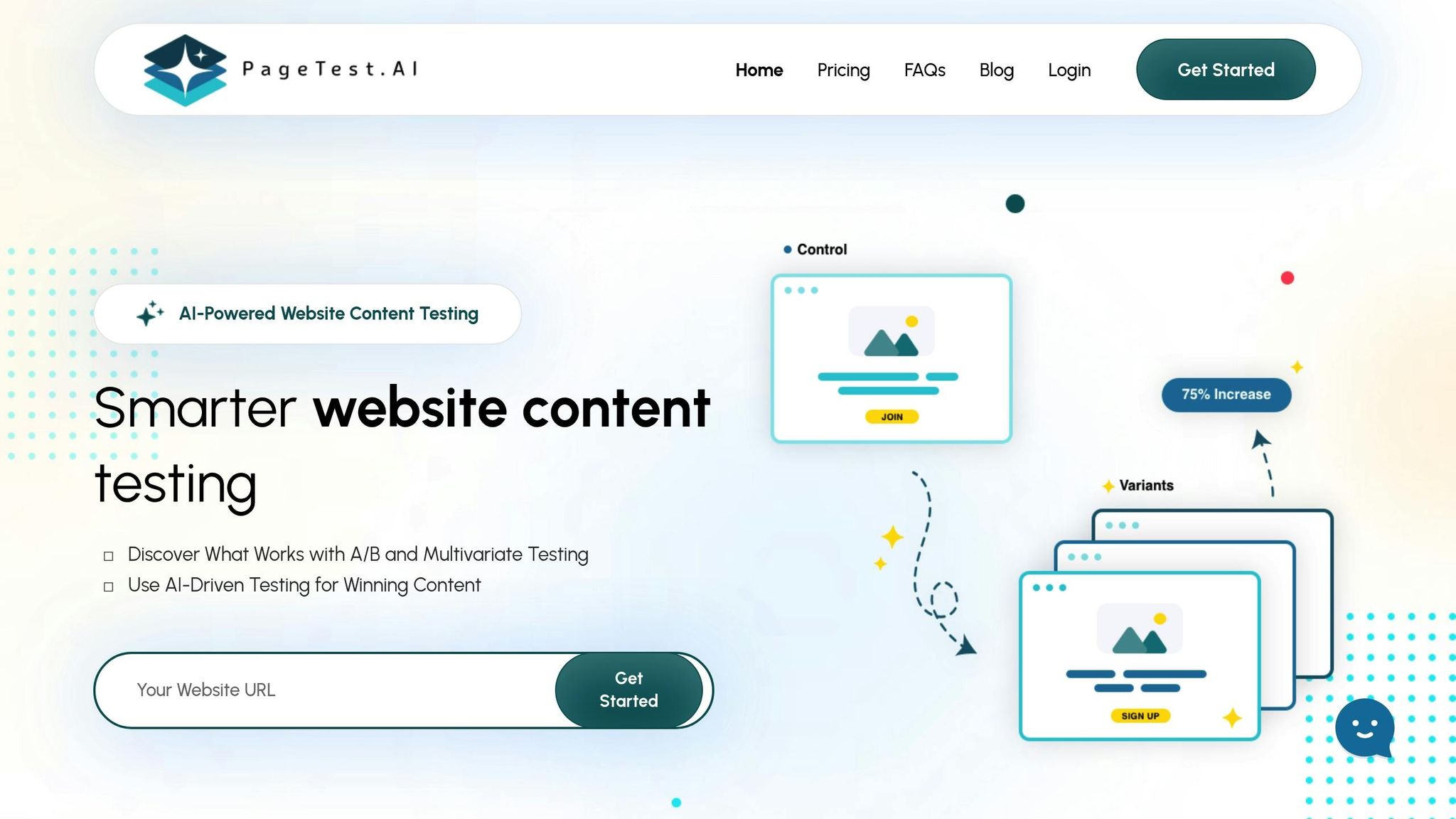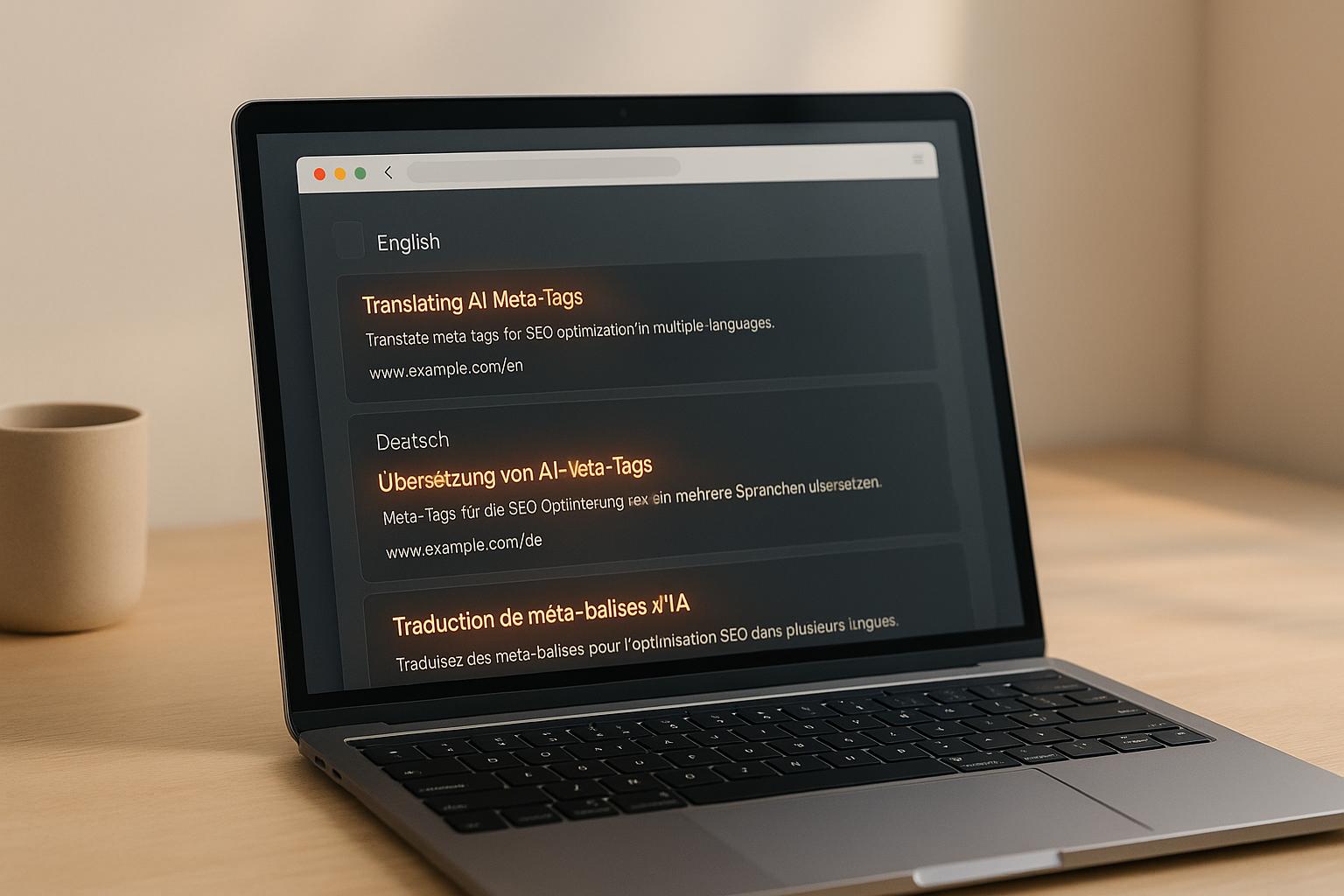

How AI Improves Mobile User Feedback Collection

How AI Improves Mobile User Feedback Collection
 17-11-2025 (Last modified: 17-11-2025)
17-11-2025 (Last modified: 17-11-2025)
AI is changing how mobile apps gather user feedback by making the process faster, smarter, and more precise. Traditional methods like email surveys are outdated, often leading to low response rates and generic insights. AI tools now offer:
- Real-time sentiment analysis: Automatically categorizes feedback as positive, negative, or neutral.
- Behavior-based prompts: Feedback requests triggered by specific user actions, like completing a purchase.
- Conversational surveys: Chatbots that engage users naturally to collect detailed feedback.
- Predictive analytics: Identifies potential issues and at-risk user segments before they escalate.
These advancements allow developers to pinpoint issues, improve app performance, and enhance user satisfaction more efficiently. AI-powered tools can boost engagement rates by up to 40% and reduce manual analysis time by 30–50%. For app developers, integrating AI into feedback collection is now essential to building better user experiences.
How to Create an AI Customer Feedback Analyzer Using AI Agent
AI-Powered Methods for Mobile Feedback Collection
Gone are the days of dull, one-size-fits-all feedback forms. Thanks to AI, mobile feedback collection has become smarter, more intuitive, and engaging. These new methods tap into user behavior to create interactions that feel natural and meaningful.
In-App Surveys and Feedback Widgets
AI has completely changed how in-app surveys work. Instead of randomly interrupting users, these systems analyze behavior to find the perfect moment to ask for input. For example, surveys might pop up right after a user completes a purchase, finishes a tutorial, or tries out a new feature.
One leading survey provider has taken this approach to the next level with event-triggered surveys. These surveys activate based on specific user actions, such as completing onboarding. Right afterward, users might see a quick three-question survey about their experience. This kind of timing has boosted response rates by 30% compared to traditional surveys.
AI also makes surveys feel more personal. It tailors questions to match each user’s experience. For instance, someone who frequently uses advanced features might get asked about those tools, while a new user might see questions about first impressions. This level of customization ensures the feedback feels relevant, not generic.
Some advanced survey tools go even further with adaptive logic. Their AI analyzes responses and adjusts follow-up questions in real-time. If a user gives a low rating, the system asks what went wrong. If the rating is positive, it might inquire about favorite features or likelihood to recommend the app. This dynamic approach ensures every question adds value.
And it doesn’t stop there – AI is also powering conversational tools to make feedback collection feel even more engaging.
AI-Driven Chatbots for Conversational Feedback
Chatbots have turned feedback collection into a two-way conversation. These AI-powered assistants engage users in real-time, asking questions in a natural, chat-like format.
One popular chatbot service offers surveys that adapt as the conversation unfolds. For example, if a user mentions a problem, the chatbot asks follow-up questions to dig deeper. On the flip side, if someone praises a feature, the bot might ask what specifically they enjoy. This conversational style captures richer and more detailed feedback than static forms ever could.
Platforms like WhatsApp have become especially popular for feedback collection. Users are already comfortable with messaging, making it easy for AI chatbots to jump into personalized conversations. These bots can handle multiple chats at once, tailoring questions based on each user’s app activity and recent interactions.
What makes these chatbots so effective is their ability to adapt. Unlike traditional surveys that stick to a script, AI chatbots analyze responses in real-time and adjust their next question accordingly. This creates a natural flow, encouraging users to share more insights.
Even better, chatbots can capture emotional context – something multiple-choice questions often miss. Users might express frustration or excitement in their own words, giving teams valuable insights into not just what users experienced, but how they felt about it.
Behavioral and Event-Based Feedback Prompts
AI doesn’t just rely on surveys and chatbots – it also uses user behavior to trigger timely feedback requests. By monitoring actions like app crashes, feature abandonment, or task completion, AI identifies key moments to ask for feedback.
For example, a leading behavioral analytics tool uses AI to detect when users encounter friction points, such as struggling with a particular screen or abandoning a process halfway through. Instead of waiting for users to report the issue, the system proactively asks for feedback about the specific problem.
Event-based triggers also connect user actions to feedback opportunities. When someone makes their first purchase, the system might wait a few minutes before asking about the checkout experience. If a user tries a new feature multiple times, AI recognizes the engagement and requests feedback about that functionality.
Timing is everything, and AI uses historical data to get it just right. Machine learning algorithms analyze user preferences, adjusting the timing of prompts for each individual. For instance, someone who regularly engages with surveys might see requests more often, while less frequent responders get fewer, more targeted prompts.
A standout onboarding analytics solution combines behavioral tracking with contextual prompts. It notices when users complete onboarding steps and triggers micro-surveys about each stage. This helps teams pinpoint exactly which parts of the user journey are working well and which need improvement.
By spacing out feedback requests intelligently, AI also avoids overwhelming users. It tracks how recently someone provided feedback and adjusts the frequency of new prompts accordingly. The result? Feedback that’s timely, relevant, and collected when users are most likely to respond.
These AI-powered methods make feedback collection seamless, capturing insights at just the right moment. By blending timing, personalization, and context, they ensure feedback is both meaningful and actionable, giving teams a deeper understanding of the user experience.
Analyzing and Acting on Mobile Feedback with AI
Gathering feedback is just the beginning; the real magic happens when AI steps in to transform heaps of comments, survey responses, and chat logs into actionable insights. Instead of wading through endless data manually, teams can quickly zero in on what users need and respond more efficiently. This streamlined process paves the way for precise, proactive strategies.
Using Sentiment Analysis and Topic Modeling
Sentiment analysis helps determine whether user feedback is positive, negative, or neutral. For instance, if a user says, "I love the new update, but the login keeps failing", AI can prioritize the critical login issue while still noting the positive feedback about the update. This dual focus ensures that teams address pressing concerns without losing sight of what’s working well.
The benefits are clear: companies using AI-powered sentiment analysis report identifying critical issues 30% faster and cutting resolution times by 25%.
Topic modeling takes this a step further by grouping similar feedback into themes. For example, if users repeatedly mention "slow loading", "frequent crashes", or "confusing navigation", the AI organizes these into distinct categories, making it easier to identify patterns that might otherwise go unnoticed.
A great example of this comes from 2025, when Zonka Feedback’s AI platform helped a SaaS company analyze over 50,000 survey responses in real time. The system uncovered a previously overlooked trend in complaints about onboarding. Acting on these insights, the company improved onboarding satisfaction by 28% in just one quarter.
Together, sentiment analysis and topic modeling create a robust system for processing feedback. Teams can quickly see which issues impact the most users, which problems spark strong negative reactions, and which features users consistently praise. With AI, thousands of feedback entries can be categorized in minutes – tasks that would take hours or even days with manual review.
Predictive Analytics for User Insights
While sentiment analysis and topic modeling focus on current feedback, predictive analytics looks ahead, forecasting trends and potential challenges. These AI tools analyze historical feedback and user behavior to predict future issues. For instance, if users frequently express frustration after a specific in-app action, predictive models can flag similar users who might face the same problem, enabling teams to provide timely support or guidance.
Predictive analytics also helps identify at-risk user segments. Take the example of a mobile banking app that used AI to analyze recurring complaints about a confusing loan application process. By pinpointing pain points like unclear instructions and slow loading times, the development team redesigned the workflow. This led to a 30% increase in successful loan applications and a 25% boost in user satisfaction scores.
Another example comes from a retail app that used predictive analytics to address complaints about checkout errors. By offering targeted in-app support and fixing bugs, the team reduced churn by 15% in just three months.
Beyond addressing immediate concerns, predictive analytics aids in resource planning and feature development. By analyzing feedback trends over time, AI can anticipate which features users might want next or highlight existing features that could become problematic. This forward-thinking approach allows teams to stay ahead of user needs instead of constantly playing catch-up.
Companies leveraging predictive analytics report reductions in churn rates by up to 20% and improvements in user retention by proactively addressing feedback trends before they escalate. These insights enable teams to fine-tune mobile experiences in real time, reinforcing the transformative power of AI in user feedback analysis.
Integrating AI Feedback Tools into Mobile Apps
To make the most of AI in mobile feedback, it’s essential to integrate tools that gather real-time user insights directly within your app. This process isn’t overly complicated – it’s about picking the right platform, following a clear plan, and setting up smart triggers to collect feedback at the most impactful moments. With a solid integration strategy, you can quickly start gathering actionable user insights.
Step-by-Step Integration of Feedback Tools
Start by choosing a platform that aligns with your technical needs. Options like Userback, Instabug, and Hotjar come with mobile SDKs that simplify the integration process.
Add the SDK to your app using tools like CocoaPods for iOS or Gradle for Android. These platforms handle much of the technical work, often requiring just a few lines of code to enable basic feedback collection.
Take TaskMaster, a productivity app, as an example. In January 2024, they integrated Userback’s SDK and saw impressive results: a 35% boost in user engagement and a 20% drop in support tickets within three months. The integration allowed users to submit feedback directly in the app, complete with screenshots and session replays. This helped the development team pinpoint and fix issues faster.
Before going live, test the integration in a staging environment. This minimizes the risk of performance issues and ensures compatibility with your existing codebase. Don’t forget to prioritize privacy compliance – make sure your implementation meets GDPR, CCPA, and platform-specific guidelines like Apple’s App Tracking Transparency requirements. Many platforms offer free trials, so you can thoroughly test the setup before committing to a paid plan.
Once the integration is complete, configure triggers to collect feedback at key moments.
Using Custom Triggers for Feedback
Custom triggers are a game-changer – they prompt users for feedback at the most relevant times, based on their actions or milestones. For example, you can set triggers for moments like completing a purchase, finishing onboarding, or achieving a milestone in a game.
Timing is everything. An e-commerce app could request feedback immediately after checkout, while a gaming app might ask users to share their thoughts after completing a level or hitting a high score. This approach leads to higher response rates.
ShopEase, an e-commerce app, used Hotjar’s contextual survey tool in March 2023 to request feedback right after purchases. This strategy resulted in a 40% higher response rate compared to traditional methods, providing valuable insights into the checkout process.
To implement custom triggers, define event listeners in your app. Most AI-powered feedback platforms support both standard and custom events, so you can tailor prompts to match your app’s user journey.
Combining Feedback with Analytics Platforms
Once your feedback tools are in place, linking them with analytics platforms can give you a deeper understanding of user behavior. This combination lets you connect what users say with how they interact with your app. Popular integrations include Google Analytics, Mixpanel, Amplitude, and Contentsquare.
For example, you might notice that users who complain about navigation issues also have longer session times and higher bounce rates on specific screens. These insights can help you prioritize fixes and evaluate whether your updates are effective.
Most modern feedback tools come with pre-built connectors for major analytics platforms. These connectors automatically sync feedback data with your analytics dashboard, creating unified reports that combine behavioral metrics with user sentiment.
| Analytics Platform | Key Integration Benefits | Setup Complexity |
|---|---|---|
| Google Analytics | Session tracking, conversion insights | Low |
| Mixpanel | Event-based feedback analysis | Medium |
| Amplitude | Mapping user journeys alongside feedback | Medium |
| Contentsquare | Heatmap analysis paired with sentiment | High |
This combined approach is a powerful tool for product teams aiming to make informed decisions. Many teams report that integrating feedback with analytics helps them identify issues 30% faster and feel more confident in their updates. Plus, it’s easier to measure the impact of changes – tracking whether addressing specific feedback improves user behavior over time becomes straightforward.
sbb-itb-6e49fcd
Benefits and Challenges of AI-Driven Feedback Collection
Understanding the strengths and obstacles of AI-driven feedback systems is crucial for improving mobile user engagement. These systems offer exciting possibilities but require thoughtful integration to succeed.
AI vs. Standard Feedback Methods
AI-driven feedback systems stand out compared to traditional methods. For instance, AI can process thousands of feedback entries at once, using natural language processing to identify patterns and gauge sentiment. On the other hand, standard methods often rely on static surveys delivered at fixed times, ignoring the user’s context. AI changes the game by enabling real-time, context-aware prompts based on specific user actions – leading to more relevant insights and higher participation rates.
Organizations using AI-driven feedback tools have reported cutting manual analysis time by 25–40%. This is because AI automates tasks like analyzing responses, tailoring surveys dynamically, and flagging key concerns.
| Feature | AI-Driven Methods | Standard Methods |
|---|---|---|
| Scalability | High (automated, real-time) | Low (manual, batch processing) |
| Real-Time Analysis | Instant processing and insights | Delayed, manual review required |
| Personalization | Dynamic, adaptive questioning | Static, one-size-fits-all |
| Response Rates | Up to 30% higher | Lower due to generic approach |
| Data Processing | Text, voice, image, video | Primarily text-based |
| Implementation | Complex initial setup | Simple but inflexible |
AI doesn’t just improve efficiency – it also transforms how feedback is gathered. Conversational AI, for example, takes this a step further. Instead of rigid survey forms, these systems engage users with follow-up questions in real time, capturing deeper insights that static surveys often miss. This interactive approach feels more natural to users and can reveal feedback that might otherwise go unnoticed.
Imagine an AI-powered platform launching a mobile survey right after a user completes a purchase. The system analyzes open-text responses instantly, tags sentiment, and highlights critical issues that could impact conversion rates. These insights allow product teams to prioritize updates based on real user data – fast and effectively.
Addressing Challenges in AI Feedback Systems
While the benefits are clear, AI feedback systems come with their own set of challenges. One major concern is data privacy. These systems often require access to sensitive information, making strong encryption and anonymization essential. Compliance with regulations like GDPR and CCPA is non-negotiable to maintain user trust.
Another hurdle is the complexity of implementation. Unlike traditional survey tools that are quick to deploy, AI-powered systems often need technical expertise and significant resources. However, modern platforms with no-code or low-code options can simplify the process. Many tools now offer SDKs for iOS and Android, prebuilt templates, and API integrations with popular analytics platforms. Testing in staging environments before a full rollout can help catch issues early and ensure smoother deployment.
Accuracy in sentiment analysis is another challenge. AI can struggle with nuanced or ambiguous feedback, such as sarcasm or culturally specific expressions. Regular human oversight is crucial to review AI-generated insights and ensure nothing is misinterpreted. Combining AI’s speed with human judgment creates more reliable and actionable outcomes.
To fully unlock the potential of AI-driven feedback systems, organizations must plan carefully, implement precisely, and maintain ongoing oversight. When done right, these systems provide insights and efficiency that traditional methods simply can’t match.
Using AI Platforms like PageTest.AI for Feedback Optimization

PageTest.AI leverages artificial intelligence to refine how mobile feedback is collected, ensuring precision through data-driven insights.
PageTest.AI for Testing and Refining Feedback Strategies
With PageTest.AI, mobile teams can experiment with headlines, calls-to-action (CTAs), and feedback prompts through AI-generated variations. Its no-code interface allows teams to set up A/B and multivariate tests without involving developers. This makes it simpler to pinpoint which versions resonate most with users, driving better engagement and response rates.
The platform tailors feedback prompts, survey questions, and CTAs based on user behavior, ensuring that requests are contextually relevant and more likely to elicit responses.
For example, a mobile e-commerce app used PageTest.AI to test various feedback prompt wordings after checkout. By experimenting with timing, placement, and language in in-app surveys, the team identified a version that boosted feedback response rates by 30%. These insights not only enhanced the checkout experience but also increased conversion rates. This demonstrates the practical value of AI-driven tools in improving feedback mechanisms.
Unlike static approaches, PageTest.AI streamlines the process of creating, testing, and analyzing feedback prompts. This automation speeds up experimentation and provides actionable recommendations that teams can implement quickly.
Additionally, the platform’s cross-platform functionality ensures businesses can maintain consistency in feedback strategies across mobile and web environments. This unified approach simplifies data analysis, supports cohesive user experiences, and delivers insights that inform broader product and marketing decisions.
Features That Accelerate Feedback Loops
PageTest.AI’s no-code design empowers teams to launch tests in minutes, fostering continuous improvement.
Real-time analytics provide immediate insights into user interactions, enabling teams to refine feedback mechanisms quickly. This shortens the time between spotting a problem and applying a solution, leading to better user engagement and satisfaction.
The platform monitors key performance metrics like clicks, engagement, and user behavior, offering a comprehensive view of user interactions.
Integrations with popular analytics tools allow businesses to merge feedback data with behavioral analytics. This enables teams to track feedback trends alongside user actions, segment responses by different stages of the user journey, and prioritize improvements based on both qualitative and quantitative insights.
Companies adopting AI-powered tools like PageTest.AI report up to a 30% increase in user engagement and a 20% boost in conversion rates compared to traditional methods. The platform’s AI-driven sentiment analysis can process and categorize thousands of feedback entries in seconds, cutting manual analysis time by over 80%.
To maximize results, businesses should establish clear goals for feedback collection, segment users for targeted prompts, and iterate based on analytics. Personalizing feedback requests, avoiding disruptions during critical user actions, and prioritizing impactful changes based on AI-driven insights are key strategies for improving user experience and conversion rates.
Conclusion: Transforming Mobile Feedback Collection with AI
AI is reshaping how mobile feedback is collected. The days of relying solely on static surveys or generic email questionnaires are fading, replaced by smarter, contextual systems that engage users at just the right moments with tailored questions.
This shift from manual processes to AI-driven automation delivers tangible improvements. These advancements highlight the clear edge AI has over traditional methods, offering a more dynamic and effective way to gather insights.
Modern AI tools excel by using behavioral triggers to prompt users naturally during their app journey. These tools analyze responses in real time, uncovering actionable insights that can lead to immediate improvements. The result? Feedback collection that feels conversational and relevant, far surpassing the static forms of the past.
When AI integrates with analytics platforms, developers gain a more comprehensive view of the user experience. This combination allows for quicker decision-making and helps teams prioritize updates that enhance engagement and retention. It’s a streamlined approach that directly impacts app quality and strengthens user relationships.
For mobile developers and businesses, adopting AI-powered feedback tools is no longer optional – it’s a necessity to stay competitive. These tools enable closed-loop feedback systems, where insights lead to rapid action, driving continuous improvements that keep users satisfied and engaged.
The results speak for themselves: companies leveraging AI-driven feedback report higher engagement, faster problem resolution, and better user experiences. As mobile users demand more in today’s competitive landscape, the ability to quickly understand and respond to their needs through AI will be a critical factor in achieving long-term success.
The future of feedback is seamless, omnichannel, and powered by AI. Teams that embrace these innovations today are setting the stage for stronger user connections and more successful mobile experiences tomorrow.
FAQs
How does AI enhance mobile user feedback collection and make it more personalized and effective?
AI is changing the way mobile user feedback is collected by streamlining the process and offering instant insights. Traditional methods often require hours of manual effort to analyze feedback, but AI-powered tools can handle large datasets in seconds, uncovering patterns and trends with ease.
What’s more, AI makes feedback more tailored to each user. By analyzing individual behavior and preferences, AI can customize survey questions or prompts based on a user’s interaction history. This approach feels more relevant and engaging, which boosts response rates and gives businesses richer insights into what their users truly want and experience.
What should you consider when using AI to collect feedback in mobile apps?
Implementing AI-powered feedback systems in mobile apps can bring plenty of advantages, but it’s not without its challenges. One of the most critical aspects is safeguarding user privacy. To do this, your system must comply with data protection regulations like GDPR or CCPA, and you need to be upfront about how user data is collected and used. Being transparent isn’t just a legal requirement – it’s how you build trust with your users.
Another important factor is making sure the AI delivers feedback that users can actually act on. To achieve this, you’ll need to train the system with relevant, high-quality data and keep refining its algorithms to account for changing user behaviors. On top of that, the AI should work smoothly with your app’s current infrastructure. A clunky integration could disrupt the user experience, which is the last thing you want.
By tackling these challenges head-on, you can use AI to collect meaningful, real-time feedback while keeping your users’ trust intact and ensuring your app runs without a hitch.
How can AI-driven predictive analytics help mobile app developers identify and resolve user issues before they become bigger problems?
AI-driven predictive analytics gives mobile app developers the power to tackle potential user issues head-on. By analyzing real-time feedback and tracking user behavior, these tools can pinpoint patterns, identify trends, and even flag unusual activity. This allows developers to predict problems like app crashes, slow loading speeds, or frustrating usability glitches – before they spiral out of control.
Armed with this information, developers can make proactive improvements, such as fine-tuning app performance or refining user interfaces. The result? A smoother, more enjoyable experience for users and a reduced risk of churn. Plus, using AI in this way helps developers focus on the most pressing updates and fixes, making their work not just smarter, but more impactful.
Related Blog Posts
say hello to easy Content Testing
try PageTest.AI tool for free
Start making the most of your websites traffic and optimize your content and CTAs.
Related Posts

 15-11-2025
15-11-2025
 Ian Naylor
Ian Naylor
Best Practices for AI Meta Tag Translation
Learn how AI-driven meta tag translation enhances multilingual SEO by improving engagement and search rankings through efficient localization.

 13-11-2025
13-11-2025
 Ian Naylor
Ian Naylor
AI Tools for Testing Visual Hierarchy
Explore how AI tools can enhance your website’s visual hierarchy, improving user experience and boosting conversion rates significantly.

 11-11-2025
11-11-2025
 Ian Naylor
Ian Naylor
How to Analyze Mobile Abandonment Patterns
Understand mobile abandonment patterns to enhance user experience and recover lost revenue by addressing key friction points during checkout and onboarding.
